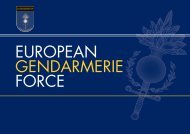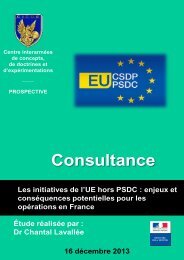Conference
science-research-bulletin-2013-conference
science-research-bulletin-2013-conference
Create successful ePaper yourself
Turn your PDF publications into a flip-book with our unique Google optimized e-Paper software.
EUROPEAN POLICE SCIENCE AND RESEARCH BULLETIN<br />
SPECIAL CONFERENCE EDITION<br />
tool in that regard as it seeks to foster among<br />
human rights activists a better understanding for<br />
the difficult, complex and often even dangerous<br />
character of the police work.<br />
REMAINING CHALLENGES<br />
With all these improvements in mutual respect<br />
and understanding, problems still persist.<br />
CONSTRUCTIVE DIALOGUE<br />
In addition, in many countries police have<br />
realised that they cannot escape public scrutiny.<br />
If they try to do so the public will not trust them<br />
and will be hostile toward them. However, police<br />
are highly dependent on trust of all parts of the<br />
population and their willingness to cooperate<br />
with the police; in the end distrust and hostility are<br />
counterproductive to good and efficient policing.<br />
Thus police have to make the best out of it and use<br />
public scrutiny to gain the trust of the population<br />
and as a means of self-evaluation. Openness to<br />
public scrutiny then also provides room for a<br />
more constructive dialogue with human rights<br />
organisations such as Amnesty International.<br />
Today, constructive dialogue is taking place<br />
in many countries; this can be in public round<br />
tables where specific issues are discussed, or in<br />
bilateral talks that are publicly known, but whose<br />
content may sometimes remain confidential<br />
depending on the agreements made. Amnesty<br />
International also often organises public events,<br />
demonstrations etc. where it is necessary to<br />
engage in dialogue with the police in order<br />
to balance interests of public order and safety<br />
with the right to peaceful assembly and protest.<br />
An example how this took place successfully ( 2 )<br />
demonstrates how apparently opposing interests,<br />
i.e. legitimate security concerns in relation to a<br />
high level State visit (Russian President Vladimir<br />
Putin’s visit to Amsterdam in April 2013) on the one<br />
hand and the right to freedom of expression on<br />
the other — can be successfully reconciled. Open<br />
and trustful discussions about the feasible and the<br />
unfeasible led to a modus operandi where it was<br />
possible for Amnesty International to express its<br />
human rights concerns and that this reached the<br />
addressee of the message, while at the same time<br />
not jeopardising security with demonstrators not<br />
getting too close to the State visit.<br />
SENSITIVE SUBJECTS: ETHNIC PROFILING<br />
Some subjects are particularly sensitive and<br />
difficult to address in a constructive dialogue.<br />
Ethnic profiling is such an example. While<br />
Amnesty International fully accepts profiling as a<br />
legitimate and necessary policing technique; it is<br />
opposed to profiling if the underlying assumptions<br />
are exclusively based on ethnicity, race or other<br />
parameters of visual appearance. Amnesty<br />
International considers such an approach as per<br />
se discriminatory. It is sometimes quite surprising<br />
how passionately many police officers react in<br />
that regard. They seem to perceive this as an<br />
accusation of racism.<br />
However, the intention of Amnesty International<br />
when criticising ethnic profiling is rather to create<br />
an understanding of the impact of this approach<br />
on those who are repeatedly affected by stop and<br />
search practices exclusively motivated by criteria of<br />
appearance. Furthermore, Amnesty International<br />
strongly believes that this technique is also<br />
inefficient and counterproductive. The affected<br />
groups start to feel harassed and discriminated<br />
against as potential criminals and they will lose<br />
trust and confidence in the police. There is thus a<br />
risk of alienating an entire group, and police run<br />
the risk of depriving themselves of an important<br />
source of information when members of these<br />
groups are no longer willing to talk to the police.<br />
Too often, stop and search activities based on<br />
optical parameters without additional objective<br />
criteria will also bind resources for relatively<br />
unsuccessful activities, while more sophisticated,<br />
focused and tested objective criteria might lead<br />
to greater efficiency (higher ‘hit rates’) with less<br />
input of resources ( 3 ); this would also contrast<br />
the problematic consequence of a self-fulfilling<br />
prophecy, in which police will receive ‘evidence’<br />
of their own assumptions of the ‘criminal<br />
character’ of a specific group compared to other<br />
people who will be considered less involved in<br />
criminal activity, only by the fact that they are not<br />
stopped, and consequently never identified as<br />
suspects. And finally, where policing parameters<br />
( 2 ) Available on Youtube: http://www.youtube.com/watch?v=xH3BNo85Ixo.<br />
( 3 ) See for instance examples presented in Open Society Justice Initiative (2012).<br />
60





